Today I passed the exam in 1st attempt.
I have a Data-warehouse and BI experience of over 3 years, which obviously helped.
Questions where you actually have to implement things you learn would be easy you have database experience.
For other questions, the Preparation is good enough. I had one pass over the entire book, but it was a detailed one.
I would say 2 weeks of time is good enough ( if you actually sit and study on all these days Big Smile )
All the best for anyone preparing for this Microsoft https://www.pass4itsure.com/70-461.html pdf !!
Exam Code: 70-461
Exam Name: Querying Microsoft SQL Server 2012
Updated: Jul 21, 2017
Q&As: 164
Choosing Microsoft 70-461 pdf study material means you choose an effective, smart, and fast way to succeed in your 070-461 pdf exam certification. You will find explanations along with the answers where is necessary in the 070-461 pdf actual test files.
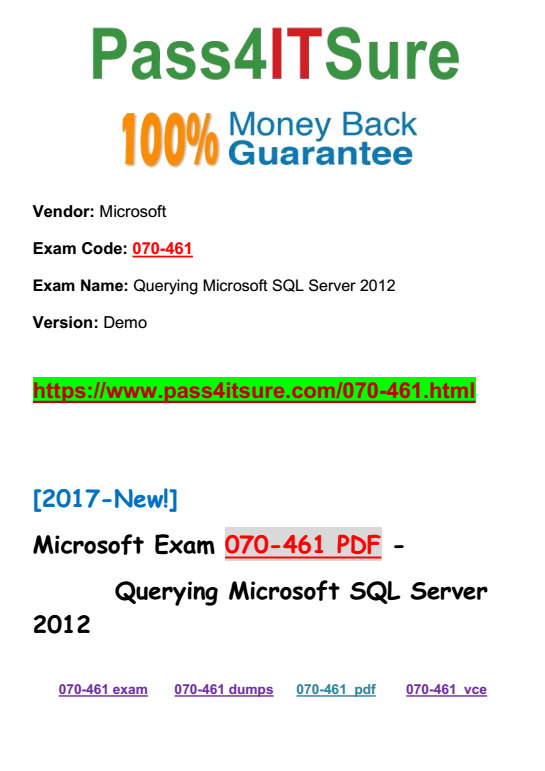
Pass4itsure Latest and Most Accurate 70-461 PDF Dumps Exam Q&As:
Question No: 26 You develop a Microsoft SQL Server 2012 database that contains a table named Products.
The Products table has the following definition: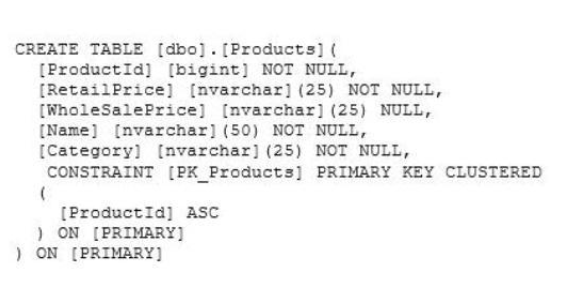
You need to create an audit record only when either the retail price or wholesale price
the column is updated.
Which Transact-SQL query should you use?
A. CREATE TRIGGER TrgPriceChange ON Products FOR UPDATE AS
IF CCLUMNS_CHANGED(retail price, wholesale price)
– – Create Audit Records
B. CREATE TRIGGER TrgPriceChange ON Products FOR UPDATE AS
IF EXISTS(SELECT RetailPrice from inserted) OR
EXISTS (SELECT WholeSalePnce FROM inserted)
– – Create Audit Records
C. CREATE TRIGGER TrgPriceChange ON Products FOR UPDATE AS
IF COLUMNS_UPDATED(retail price, wholesale price)
– – Create Audit Records
D. CREATE TRIGGER TrgPriceChange ON Products FOR UPDATE AS
IF UPDATE(retail price) OR UPDATE(wholesale price)
– – Create Audit Records
070-461 pdf Answer: D
Question No: 27 A table named Profits stores the total profit made each year within a territory. The Profits
the table has columns named Territory, Year, and Profit.
You need to create a report that displays the profits made by each territory for each year
and its previous year.
Which Transact-SQL query should you use?
A. SELECT Territory, Year, Profit,
LEAD(Profit, 1, 0) OVER (PARTITION BY Territory ORDER BY Year) AS PrevProfit
FROM Profits
B. SELECT Territory, Year, Profit,
LAG(Profit, 1, 0) OVER (PARTITION BY Year ORDER BY Territory) AS PrevProfit
FROM Profits
C. SELECT Territory, Year, Profit,
LAG(Profit, 1, 0) OVER (PARTITION BY Territory ORDER BY Year) AS PrevProfit
FROM Profits
D. SELECT Territory, Year, Profit,
LEAD(Profit, 1, 0) OVER (PARTITION BY Year ORDER BY Territory) AS PrevProfit
FROM Profits
Answer: C
Question No: 28 You use Microsoft SQL Server 2012 database to develop a shopping cart application.
You need to rotate the unique values of the ProductName field of a table-valued expression
into multiple columns in the output.
Which Transact-SQL operator should you use?
A. CROSS JOIN
B. CROSS APPLY
C. PIVOT
D. UNPIVOT
070-461 exam Answer: C
Explanation:
Question No: 29 You administer a Microsoft SQL Server database that supports a shopping application.
You need to retrieve a list of customers who live in territories that do not have a salesperson. Which Transact- SQL query or queries should you use? (Each correct answer presents a
complete solution. Choose all that apply.)
A. SELECT CustomerID FROM Customer
WHERE TerritoryID <> SOME(SELECT TerritoryID FROM Salesperson)
B. SELECT CustomerID FROM Customer
WHERE TerritoryID <> ALL(SELECT TerritoryID FROM Salesperson)
C. SELECT CustomerID FROM Customer
WHERE TerritoryID <> ANY(SELECT TerritoryID FROM Salesperson)
D. SELECT CustomerID FROM Customer
WHERE TerritoryID NOT IN(SELECT TerritoryID FROM Salesperson) Answer: B, D
You support a database structure shown in the exhibit. (Click the Exhibit button.)
Question No: 30
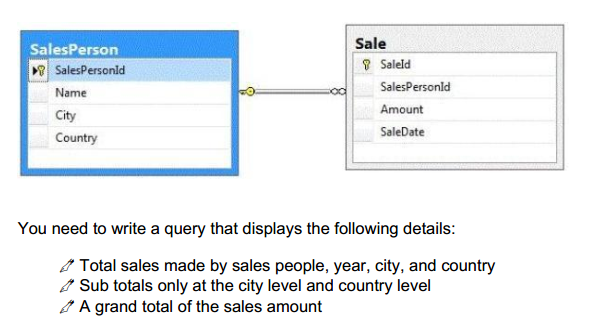
Which Transact-SQL query should you use?
A. SELECT SalesPerson.Name, Country, City,
DatePart(yyyy, SaleDate) AS Year, Sum(Amount) AS Total
FROM Sale INNER JOIN SalesPerson
ON Sale.SalesPersonID = SalesPerson.SalesPersonID
GROUP BY GROUPING SETS((SalesPerson.Name, Country, City, DatePart(yyyy,
SaleDate)), (Country, City), (Country), ())
B. SELECT SalesPerson.Name, Country, City,
DatePart(yyyy, SaleDate) AS Year, Sum(Amount) AS Total
FROM Sale INNER JOIN SalesPerson
ON Sale.SalesPersonID = SalesPerson.SalesPersonID
GROUP BY CUBE(SalesPerson.Name, Country, City, DatePart(yyyy, SaleDate))
C. SELECT SalesPerson.Name, Country, City,
DatePart(yyyy, SaleDate) AS Year, Sum(Amount) AS Total
FROM Sale INNER JOIN SalesPerson
ON Sale.SalesPersonID = SalesPerson.SalesPersonID
GROUP BY CUBE(SalesPerson.Name, DatePart(yyyy, SaleDate), City, Country)
D. SELECT SalesPerson.Name, Country, City,
DatePart(yyyy, SaleDate) AS Year, Sum(Amount) AS Total
FROM Sale INNER JOIN SalesPerson
ON Sale.SalesPersonID = SalesPerson.SalesPersonID
GROUP BY ROLLUP(SalesPerson.Name, DatePart(yyyy, SaleDate), City, Country)
070-461 dumps Answer: A
Explanation:
Be careful with this question, because on an exam can be different options for answer.
And none of them is correct : D You should report this question.
You are developing a database that will contain price information. You need to store the
prices that include a fixed precision and a scale of six digits. Which data type should you
use?
A. Float
B. Money
C. Small money
D. Numeric
Answer: D
Explanation:
Numeric is the only one in the list that can give a fixed precision and scale.
Question No: 31
You administer a Microsoft SQL Server database that supports a banking transaction
management application.
You need to retrieve a list of account holders who live in cities that do not have a branch
location.
Which Transact-SQL query or queries should you use? (Each correct answer presents a
Question No: 32
complete solution. Choose all that apply.)
A. SELECT AccountHolderID
FROM AccountHolder
WHERE CityID NOT IN (SELECT CityID FROM BranchMaster)
B. SELECT AccountHolderID
FROM AccountHolder
WHERE CityID <> ALL (SELECT CityID FROM BranchMaster)
C. SELECT AccountHolderlD
FROM AccountHolder
WHERE CityID <> SOME (SELECT CityID FROM BranchMaster)
D. SELECT AccountHolderID
FROM AccountHolder
WHERE CityID <> ANY (SELECT CityID FROM BranchMaster)
70-461 vce Answer: A, B
Explanation:
Verified the answers as correct.
You administer a Microsoft SQL Server 2012 database. The database contains a table
named Employee. Part of the Employee table is shown in the exhibit. (Click the Exhibit
button.)
Question No: 33
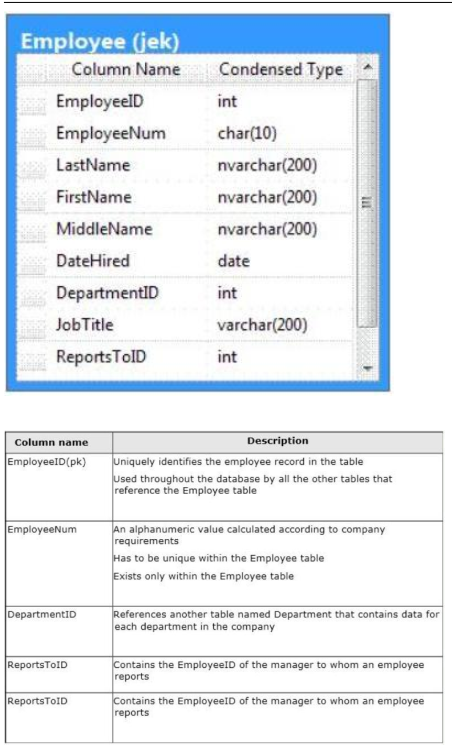
Confidential information about the employees is stored in a separate table named
employee data. One record exists within EmployeeData for each record in the Employee
table. You need to assign the appropriate constraints and table properties to ensure data
integrity and visibility. On which column in the Employee table should you create a unique
constraint?
A. DateHired
B. DepartmentID
C. employed
D. EmployeeNum
E. FirstName
F. JobTitle
G. LastName
H. MiddleName
I. ReportsToID
Answer: D
You administer a Microsoft SQL Server 2012 database. The database contains a table
named Employee. Part of the Employee table is shown in the exhibit. (Click the Exhibit
button.)
Question No: 34
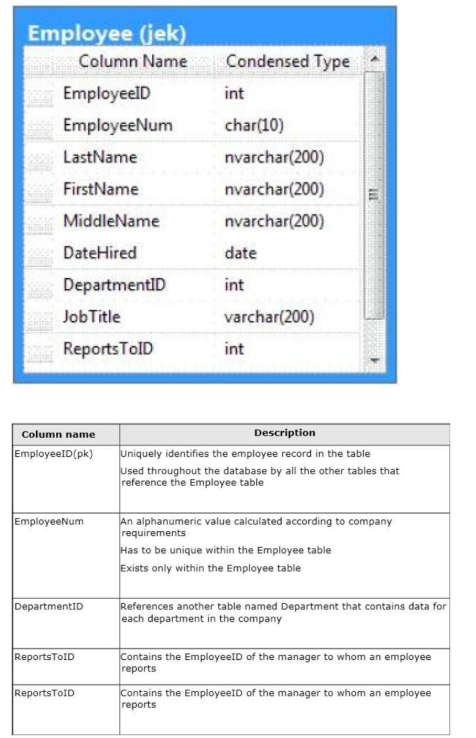
✑ ✑
Confidential information about the employees is stored in a separate table named
employee data. One record exists within EmployeeData for each record in the Employee
table.
You need to assign the appropriate constraints and table properties to ensure data integrity
and visibility.
On which column in the Employee table should you use an identity specification to include
a seed of 1,000 and an increment of 1?
A. DateHired
B. DepartmentID
C. EmployeeID
D. EmployeeNum
E. FirstName
F. JobTitle
G. LastName
H. MiddleName
I. ReportsToID
70-461 pdf Answer: C
You administer a Microsoft SQL Server 2012 database that includes a table named
Products. The Products table has columns named Productld, ProductName, and
CreatedDateTime.
The table contains a unique constraint on the combination of ProductName and
CreatedDateTime.
You need to modify the Products table to meet the following requirements:
Remove all duplicates of the Products table based on the ProductName column.
Retain only the newest Product row.
Which Transact-SQL query should you use?
A. WITH CTEDupRecords
AS
Question No : 35
SELECT MAX(CreatedDateTime) AS CreatedDateTime, ProductName
FROM Products
GROUP BY ProductName
HAVING COUNT(*) > 1
)
DELETE p
FROM Products p
JOIN CTEDupRecords cte ON
B. ProductName = cte.ProductName
AND p.CreatedDateTime > cte.CreatedDateTime
C. WITH CTEDupRecords
AS
(
SELECT MAX(CreatedDateTime) AS CreatedDateTime, ProductName
FROM Products
GROUP BY ProductName
HAVING COUNT(*) > 1
)
DELETE p
FROM Products p
JOIN CTEDupRecords cte ON
cte.ProductName = p.ProductName
AND cte.CreatedDateTime > p.CreatedDateTime
D. WITH CTEDupRecords
AS
(
SELECT MIN(CreatedDateTime) AS CreatedDateTime, ProductName
FROM Products
GROUP BY ProductName
)
DELETE p
FROM Products p
JOIN CTEDupRecords cte ON
E. ProductName = cte.ProductName
F. WITH CTEDupRecords
AS
(
SELECT MAX(CreatedDateTime) AS CreatedDateTime, ProductName
FROM Products
GROUP BY ProductName
HAVING COUNT(*) > 1
)
DELETE p
FROM Products p
JOIN CTEDupRecords cte ON
G. ProductName = cte.ProductName
Answer: B
Question No: 36You develop three Microsoft SQL Server 2012 databases named Database1, Database2,
and Database3.
You have permissions on both Database1 and Database2. You plan to write and deploy a
stored procedure named dbo.usp_InsertEvent in Database3. dbo.usp_InsertEvent must
execute other stored procedures in the other databases.
You need to ensure that callers that do not have permissions on Database1 or Database2
can execute the stored procedure.
Which Transact-SQL statement should you use?
A. USE Database2
B. EXECUTE AS OWNER
C. USE Database1
D. EXECUTE AS CALLER
070-461 dumps Answer: B
Question No: 37 You administer a Microsoft SQL Server 2012 database that has multiple tables in the Sales
schema. Some users must be prevented from deleting records in any of the tables in the
Sales schema. You need to manage users who are prevented from deleting records in the
Sales schema.
You need to achieve this goal by using the minimum amount of administrative effort. What
should you do? A. Create a custom database role that includes the users. Deny Delete permissions on the
Sales schema for the custom database role.
B. Include the Sales schema as an owned schema for the db_denydatawriter role. Add the
users to the
db_denydatawriter role.
C. Deny Delete permissions on each table in the Sales schema for each user.
D. Create a custom database role that includes the users. Deny Delete permissions on
each table in the Sales schema for the custom database role.
Answer: A
You administer a Microsoft SQL Server 2012 database. The database contains a Product
table created by using the following definition:
Question No: 38
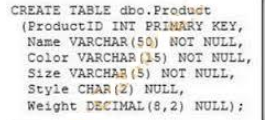
You need to ensure that the minimum amount of disk space is used to store the data in the
Product table.
What should you do?
A. Convert all indexes to Column Store indexes.
B. Implement Unicode Compression.
C. Implement row-level compression.
D. Implement page-level compression.
070-461 vce Answer: D
You generate a daily report according to the following query:
Question No: 39
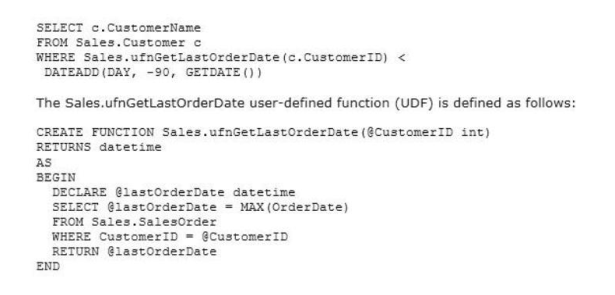
You need to improve the performance of the query.
What should you do?
A. Drop the UDF and rewrite the report query as follows:
WITH cte(CustomerID, LastOrderDate) AS (
SELECT CustomerID, MAX(OrderDate) AS [LastOrderDate]
FROM Sales.SalesOrder
GROUP BY CustomerID
)
SELECT c.CustomerName
FROM cte
INNER JOIN Sales.Customer c
ON cte.CustomerID = c.CustomerID
WHERE cte.LastOrderDate < DATEADD(DAY, -90, GETDATE())
B. Drop the UDF and rewrite the report query as follows:
SELECT c.CustomerName
FROM Sales.Customer c
WHERE NOT EXISTS (
SELECT s.OrderDate
FROM Sales.SalesOrder
WHERE s.OrderDate > DATEADD(DAY, -90, GETDATE())
AND s.CustomerID = c.CustomerID)
C. Drop the UDF and rewrite the report query as follows:
SELECT DISTINCT c.CustomerName
FROM Sales.Customer c
INNER JOIN Sales.SalesOrder s
ON c.CustomerID = s.CustomerID
WHERE s.OrderDate < DATEADD(DAY, -90, GETDATE())
D. Rewrite the report query as follows:
SELECT c.CustomerName
FROM Sales.Customer c
WHERE NOT EXISTS (SELECT OrderDate FROM
Sales.ufnGetRecentOrders(c.CustomerID,
90))
Rewrite the UDF as follows:
CREATE FUNCTION Sales.ufnGetRecentOrders(@CustomerID int, @MaxAge DateTime)
RETURNS TABLE AS RETURN (
SELECT OrderDate
FROM Sales.SalesOrder
WHERE s.CustomerID = @CustomerID
AND s.OrderDate > DATEADD(DAY, -@MaxAge, GETDATE())
070-461 exam Answer: A
You administer a Microsoft SQL Server 2012 database named ContosoDb. Tables are
defined as shown in the exhibit. (Click the Exhibit button.)
Question No : 40
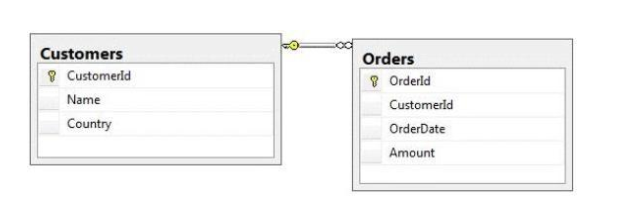
You need to display rows from the Orders table for the Customers row having the
CustomerId value set to 1 in the following XML format:
<row OrderId=”1″ OrderDate=”2000-01-01T00:00:00″ Amount=”3400.00″
Name=”Customer
A” Country=”Australia” />
<row OrderId=”2″ OrderDate=”2001-01-01T00:00:00″ Amount=”4300.00″
Name=”Customer
A” Country=”Australia” />
Which Transact-SQL query should you use?
A. SELECT OrderId, OrderDate, Amount, Name, Country
FROM Orders INNER JOIN Customers ON Orders.CustomerId = Customers.CustomerId
WHERE Customers.CustomerId = 1
FOR XML RAW
B. SELECT OrderId, OrderDate, Amount, Name, Country
FROM Orders INNER JOIN Customers ON Orders.CustomerId = Customers.CustomerId
WHERE Customers.CustomerId = 1
FOR XML RAW, ELEMENTS
C. SELECT OrderId, OrderDate, Amount, Name, Country
FROM Orders INNER JOIN Customers ON Orders.CustomerId = Customers.CustomerId
WHERE Customers.CustomerId = 1
FOR XML AUTO
D. SELECT OrderId, OrderDate, Amount, Name, Country
FROM Orders INNER JOIN Customers ON Orders.CustomerId – Customers.CustomerId
WHERE Customers.CustomerId= 1
FOR XML AUTO, ELEMENTS
E. SELECT Name, Country, OrderId, OrderDate, Amount
FROM Orders INNER JOIN Customers ON Orders.CustomerId= Customers.CustomerId
WHERE Customers.CustomerId- 1
FOR XML AUTO
F. SELECT Name, Country, Ordered, OrderDate, Amount
FROM Orders INNER JOIN Customers ON Orders.CustomerId= Customers.CustomerId
WHERE Customers.CustomerId= 1
FOR XML AUTO, ELEMENTS
G. SELECT Name AS ‘@Name’, Country AS ‘@Country’, OrderId, OrderDate, Amount
FROM Orders INNER JOIN Customers ON Orders.CustomerId= Customers.CustomerId
WHERE Customers.CustomerId= 1
FOR XML PATH (‘Customers’)
H. SELECT Name AS ‘Customers/Name’, Country AS ‘Customers/Country’, OrderId,
OrderDate, Amount
FROM Orders INNER JOIN Customers ON Orders.CustomerId= Customers.CustomerId
WHERE Customers.CustomerId= 1
FOR XML PATH (‘Customers’)
Answer: A
You have a database that contains the tables as shown in the exhibit. (Click the Exhibit
button.)
Question No: 41 CORRECT TEXT
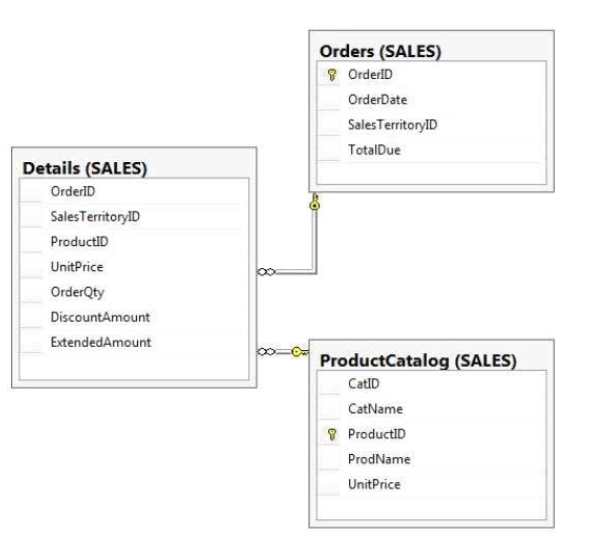
You have the following query:
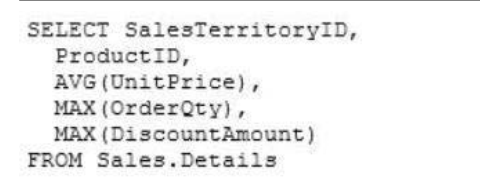
✑ ✑ ✑ ✑
You need to recreate the query to meet the following requirements:
Reference columns by using one-part names only.
Sort aggregates by SalesTerritoryID, and then by ProductID.
Order the results in descending order from SalesTerritoryID to Product
The solution must use the existing SELECT clause and FROM clause
Which code segment should you use?
To answer, type the correct code in the answer area.
Answer: Please review the explanation part for this answer
Answer:
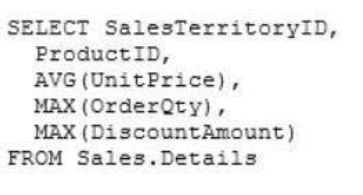
With the study by the Pass4itsure 070-461 pdf, you will have a clear understanding of the 070-461 pdf valid dumps. In addition, you can print the 070-461 pdf dumps into papers, thus you can do marks on the papers. Every time, when you review the papers, you will enhance your memory about the marked points. Be confident to attend your 070-461 pdf exam test, you will pass successfully.
The Microsoft Certification website and this preparation guide contain a variety of resources to help you prepare for an exam. Preparing for and taking a Pass4itsure https://www.pass4itsure.com/70-461.html pdf exam — FAQ provides answers to frequently asked questions about exam registration, preparation, scoring, and policies, including google drive: https://drive.google.com/open?id=0BwxjZr-ZDwwWRFNLVl8xNFJPejg

